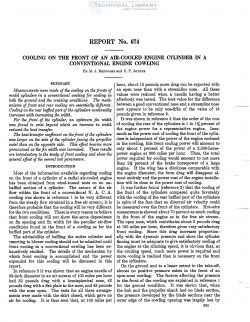naca-report-674

- Version
- 189 Downloads
- 1.32 MB File Size
- 1 File Count
- August 30, 2016 Create Date
- August 30, 2016 Last Updated
National Advisory Committee for Aeronautics, Report - Cooling on the Front of an Air Cooled Engine Cylinder in a Conventional Engine Cowling

Measurements were made of the cooling on the fronts of
model cylinders in a conventional cowling for cooling in
both the ground and the cruising conditions. The mech-
anisms of front and rear cooling are essentially diferent.
Cooling on the rear bafied part of the cylinders continually
increases with increasing fin width.
For the front of the cylinder, an optimum fin width
was found to exist beyond which an increase in width
reduced the heat transfer.
The heat-transfer coeficient on the front of the cylinders
was larger on the side of the cylinder facing the propeller
swirl than on the opposite side. This eject became more
pronounced as the fin width was increased. These results
are introductory to the study of front cooling and show the
general effect of the sereral test parameters.
Most of the information available regarding cooling
on the front of a cylinder of a radial air-cooled engine
has been obtained from Wind-tunnel tests on an un-
bafiEled section of a_cylinder. The nature of the air
flow within the front of a conventional N. A. C. A.
cowling was shown in reference 1 to be very different
from the steady flow obtained in a free air stream; it is
therefore probable that the cooling will be very difl’erent
for the two conditions. There is every reason to believe
that front cooling will not show the same dependence
on fin spacing and fin width for the peculiar air-flow
conditions found in the front of a cowling as for the
baffled part of the cylinder.
The advisability of battling the entire cylinder and
resorting to blower cooling should not be admitted until
front cooling in a conventional cowling has been ex-
haustively studied. The details of the mechanism by
which front cooling is accomplished and the power
expended for this cooling will be discussed in this
report.
| File | Action |
|---|---|
| naca-report-674 Cooling on the Front of an Air Cooled Engine Cylinder in a Conventional Engine Cowling.pdf | Download |
Comment On This Post